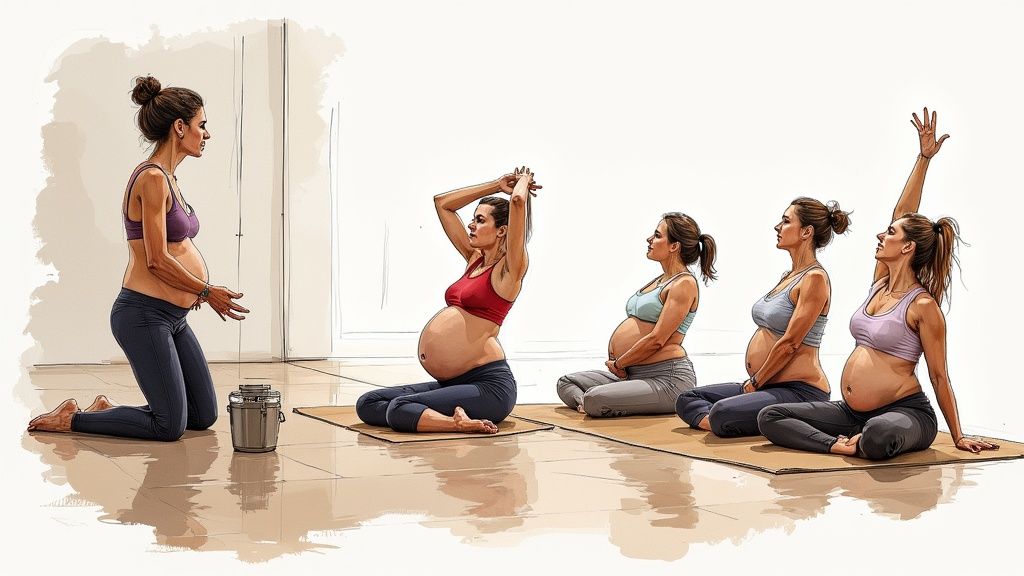The Real Impact of Prenatal Yoga on Birth Outcomes

When it comes to preparing for childbirth, prenatal yoga stands out as one of the most effective practices available to expecting mothers. Research consistently shows its positive effects on birth experiences and outcomes. A compelling study from South Wales found that an impressive 83% of first-time mothers who attended at least six prenatal yoga classes had spontaneous vaginal births – a finding that caught the attention of both medical professionals and expectant parents.
Understanding the Connection Between Yoga and Natural Birth
The high number of spontaneous vaginal births among yoga practitioners isn’t just a coincidence. Regular practice helps women develop body awareness and breathing techniques that prove invaluable during labor. Many women report feeling more connected to their changing bodies and better equipped to handle the challenges of childbirth. As one mom shared, “The breathing exercises I learned in yoga class became my anchor during contractions.” This increased confidence often translates into more positive birth experiences.
How Prenatal Yoga Facilitates Labor Progress
The benefits of prenatal yoga become especially apparent during labor itself. Research shows that women who practice yoga regularly, particularly in their third trimester, often experience shorter first-stage labor times. This makes sense when you consider how yoga helps maintain muscle strength and flexibility – both essential for an efficient birthing process. The calming effects of regular practice also help women stay relaxed during labor, which can prevent tension from slowing things down.
The Role of Breathing Techniques and Specific Poses
In prenatal yoga classes, women learn practical tools they’ll use during labor. Cat-cow poses and pelvic tilts, for example, help maintain hip mobility and core strength. These movements, combined with focused breathing practices, support optimal baby positioning and give women concrete ways to work with their bodies during contractions. The classroom setting allows expectant mothers to practice these techniques with guidance, building muscle memory they’ll draw upon during birth.
Beyond the Physical: Mental Wellbeing and Prenatal Yoga
The benefits of prenatal yoga reach far beyond physical preparation for birth. Classes provide a supportive community where women can share their experiences and concerns. Many mothers find that regular practice helps them sleep better, worry less, and feel more emotionally balanced throughout their pregnancy. This mental preparation proves just as valuable as the physical aspects, helping women approach birth and early parenthood with greater confidence and calm. The combination of physical practice and emotional support makes prenatal yoga a complete preparation system for childbirth.
Mastering Labor Preparation Through Mindful Movement

Prenatal yoga offers essential physical and mental preparation for childbirth that goes far beyond basic stretching. The mind-body connection developed through regular practice helps expecting mothers tune into their changing bodies and build strength for labor. Through guided movement and breathing techniques, women learn practical tools they can use during delivery.
Targeted Poses and Breathing for Labor
Key yoga poses directly support the birthing process. Cat-cow stretches help keep the pelvis mobile and ease common pregnancy back pain. Pelvic tilts build core strength that’s crucial during labor. When combined with focused breathing exercises, these movements become even more effective. The breathing techniques taught in prenatal yoga classes give moms practical ways to stay calm during contractions and rest between them. This hands-on practice helps women feel more confident about managing labor intensity.
The Impact on Labor Duration and Pain Management
Research shows encouraging results about prenatal yoga’s effects on labor. Women who practice regularly, especially in their third trimester, often experience shorter first-stage labor times. This likely stems from the increased strength and flexibility they develop, which helps their bodies work more efficiently during birth. Many women find they need less pain medication, instead drawing on the natural coping strategies they’ve learned through yoga. This gives them more control over their birth experience.
Optimizing Fetal Positioning Through Yoga
Gentle yoga poses can help encourage good positioning for birth. Under expert guidance, modified inversions may assist breech babies in turning head-down. Poses like the goddess pose and the child’s pose creates more space in the pelvis and hips, making it easier for babies to descend during labor. Beyond the physical benefits, these practices help build a mother’s confidence as she prepares for birth.
Real Experiences: Prenatal Yoga’s Lasting Benefits
The positive effects of prenatal yoga shine through in mothers’ birth stories. Women consistently report feeling more prepared and connected to their bodies during labor after taking regular classes. One mom shared how the breathing exercises became her anchor during intense contractions, helping her stay focused and manage discomfort. Another described the deep sense of connection she felt with her baby during yoga sessions – a bond that continued through delivery. These personal accounts show how prenatal yoga supports both the physical and emotional aspects of birth preparation, making it a valuable resource for expecting mothers.
Building Emotional Resilience for Pregnancy and Beyond
The physical changes during pregnancy are obvious, but the emotional journey is just as significant and often goes undiscussed. Prenatal yoga provides a safe space for moms-to-be to develop inner strength while connecting with their changing bodies and emotions. The practice offers practical tools and techniques that help women prepare not just for birth, but for the entire journey of motherhood.
The Power of Connection and Support
Walking into a prenatal yoga class means joining a community of women sharing similar experiences. This sense of connection makes a real difference – whether it’s trading morning sickness remedies or voicing worries about labor, having others who truly understand helps normalize the ups and downs of pregnancy. Many women form lasting friendships in these classes that continue to provide support long after their babies arrive. The shared experience creates an environment where it’s okay to be vulnerable and ask for help when needed.
Mindfulness Practices for Emotional Wellbeing
The gentle movements in yoga classes are just one part of the experience. Students also learn breathing techniques, meditation, and visualization that help calm anxious thoughts and reduce stress. These aren’t just relaxation tools – they’re practical skills women can use during labor contractions and those challenging early days with a newborn. The mindful approach helps women tune into their bodies with acceptance and kindness, which is especially important as their shapes change throughout pregnancy.
Building Confidence and Reducing Anxiety Through Movement
Learning specific poses and breathing patterns gives women a sense of preparedness for birth. Hip openers and pelvic exercises directly support the birthing process, while breath awareness provides a way to stay centered during contractions. This active preparation helps reduce fear around labor and delivery. The physical benefits matter too – better sleep, increased strength, and improved flexibility all contribute to a more positive pregnancy experience. Research consistently shows that staying active during pregnancy improves mood and reduces anxiety.
Long-Term Benefits for Motherhood
The tools gained in prenatal yoga serve women well beyond pregnancy and birth. The breathing techniques that helped during labor can calm a racing mind during midnight feedings. The supportive community remains a source of encouragement during the adjustment to motherhood. Most importantly, the self-awareness and inner strength developed through regular practice help women trust themselves as they navigate the intense emotions and daily challenges of caring for a new baby. Prenatal yoga provides practical and emotional preparation for the profound journey ahead.
Navigating Your Perfect Prenatal Yoga Practice

Starting prenatal yoga is an excellent way to support your pregnancy journey. With so many class options available, it’s helpful to understand what to look for to find the right fit. Let’s explore how to choose a practice that works best for you and your changing needs during pregnancy.
Choosing the Right Class Format and Style
When exploring prenatal yoga, you’ll find both in-person and virtual options. In-person classes provide direct guidance from instructors who can help adjust your poses. For instance, if you’re dealing with lower back pain, your teacher can suggest specific modifications right there in class. The social aspect is another big plus – you’ll meet other expecting moms and build connections. The main trade-off is that you’ll need to travel to class at set times.
Online classes give you more flexibility to practice whenever and wherever works for you. This can be perfect if you have an unpredictable schedule or prefer staying close to home. While you won’t get hands-on adjustments, many virtual classes offer clear instructions and multiple pose options. Some yoga studios now offer both formats, so you can mix and match based on your needs each week.
The style of yoga matters too. Some classes focus mainly on gentle stretching and breathing, while others include more active flowing sequences. Consider your current fitness level and what feels good for your body. If you’re new to yoga or looking for stress relief, a slower-paced class might be ideal. If you regularly exercised before pregnancy, you may enjoy a more dynamic practice.
Finding a Qualified Instructor
Your instructor’s training and experience make a big difference in your prenatal yoga experience. Look for teachers who have completed specialized prenatal yoga certification – this means they understand how to safely guide pregnant women through practice. A good instructor creates a warm, inclusive atmosphere where everyone feels comfortable asking questions.
Feel free to chat with potential teachers before joining their class. Ask how they modify poses throughout pregnancy and how they incorporate breathing techniques. For example, they should know how to adjust balance poses as their center of gravity shifts in later trimesters. The best instructors emphasize working with your changing body while helping you build strength and flexibility safely.
Practical Considerations: Cost, Time, and Sustainability
As you choose a class, think about the practical elements that will help you maintain a consistent practice. Compare prices between different studios and online options to find something that fits your budget. Consider how class times align with your schedule and how far you’re willing to travel. The key is finding a practice you can realistically stick with throughout your pregnancy. While cost is a factor, remember that prenatal yoga offers valuable physical and mental benefits that support both you and your baby. Taking time to find the right class format, teacher, and schedule will help you create a nurturing practice for your pregnancy journey.
Creating a Safe and Effective Practice Framework
Safety is a top priority when practicing prenatal yoga. By understanding key guidelines and adapting your practice appropriately, you can experience the full benefits while protecting yourself and your baby during each stage of pregnancy.
Understanding Trimester-Specific Adaptations
Your body’s needs shift significantly throughout pregnancy, requiring different yoga approaches for each trimester. In the first trimester, when fatigue and nausea are common, gentle poses and restorative practices work best. Simple poses like child’s pose can help ease discomfort and reduce stress during this early phase.
The second trimester often brings renewed energy, making it an ideal time to build strength and balance. Modified versions of poses like warrior II can be particularly helpful. However, it’s important to skip deep twists and backbends to avoid straining your growing belly. Listen to your body and adjust poses as needed.
As you enter the third trimester, focus shifts to poses that prepare for labor and delivery. Pelvic tilts and gentle hip openers become especially valuable. With your changing center of gravity, maintaining proper alignment is key – think of making small adjustments to stay comfortable and stable in each pose.
Recognizing Warning Signs and Modifications
Staying alert to your body’s signals helps prevent injury or strain during prenatal yoga. Some poses need adaptation or should be avoided completely – for example, most inversions aren’t recommended, especially later in pregnancy.
Pay close attention to warning signs like dizziness or breathing difficulties. If a pose feels uncomfortable, take a break and rest. Working with a qualified prenatal yoga instructor helps ensure you’re practicing safely. They can suggest specific modifications based on your needs and stage of pregnancy.
Ensuring Safety During Home Practice
While studio classes offer expert guidance, practicing at home can be both convenient and beneficial. Create a quiet space free from distractions where you can focus fully on your practice.
Support props like blocks and blankets help maintain proper alignment and comfort in poses. Remember to move at a moderate pace, stay well-hydrated, and never push beyond your comfort zone. Getting input from your healthcare provider and a prenatal yoga instructor helps build a safe home practice routine.
Special Considerations for High-Risk Pregnancies
Prenatal yoga can benefit women with high-risk pregnancies by reducing stress and building strength. However, close coordination with your healthcare team is essential. Your doctor and prenatal yoga instructor can help design a practice that addresses your specific needs while keeping safety the priority.
Some poses may need to be modified or avoided based on your particular situation. For instance, women with preeclampsia typically need to avoid inversions and vigorous poses. Regular check-ins with your medical team ensure your practice continues supporting your wellbeing throughout pregnancy.
Launching Your Prenatal Yoga Journey with Confidence

Taking your first prenatal yoga class is an exciting step in your pregnancy journey. Whether you’re completely new to yoga or have an existing practice, this guide will help you start and maintain a nurturing routine that supports both you and your growing baby.
Overcoming Initial Hurdles
It’s completely normal to feel unsure about starting prenatal yoga. Many women worry about keeping up in class or wonder if they have enough experience. The good news is that prenatal classes welcome women of all fitness levels and backgrounds. Teachers offer plenty of pose variations to match your comfort level and changing body. You’ll also find yourself among other expectant moms who share similar experiences and concerns. This supportive environment helps ease first-class jitters so you can focus on your practice.
Essential Preparation and Setting the Stage
A few simple items can make your yoga practice more comfortable and effective. Start with a quality yoga mat for stability and cushioning. Props like blocks and bolsters help you modify poses as your belly grows and maintain proper form. At home, designate even a small area as your yoga space – perhaps a peaceful corner of your bedroom. Having this dedicated spot helps you stay consistent with your practice and creates a calming environment free from distractions.
Setting Realistic Goals and Tracking Progress
When starting prenatal yoga, begin with goals you can realistically achieve. Try committing to two classes per week at first. As you build strength and get more comfortable, you can slowly add more sessions if you’d like. Remember that regular short practices are more beneficial than occasional long ones. Think of your yoga practice like tending a garden – small, consistent efforts yield the best results over time. Keeping a simple journal of your classes and how you feel afterward can boost your motivation and show your progress week by week.
Navigating Common Challenges
Like any new activity during pregnancy, prenatal yoga comes with its own set of challenges. Early pregnancy fatigue is especially common. Pay attention to what your body needs each day – sometimes that means taking it easier or shortening your practice. If a full flow feels like too much, try gentle stretching or restorative poses instead. Finding time for class can also be tricky. Look for studios offering flexible schedules and online options to fit your routine. Planning for potential obstacles helps you maintain a steady practice throughout your pregnancy journey.
For expectant mothers in India seeking a supportive and complete pregnancy experience, Pregnancy 101 offers expert-led live sessions on prenatal and postnatal care, Garbh Sanskar, and informative events. With adaptable scheduling and experienced instructors, Pregnancy 101 helps women navigate pregnancy with confidence.

